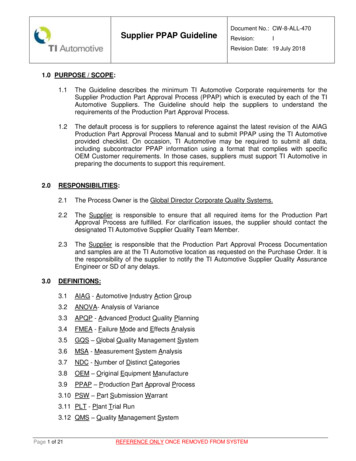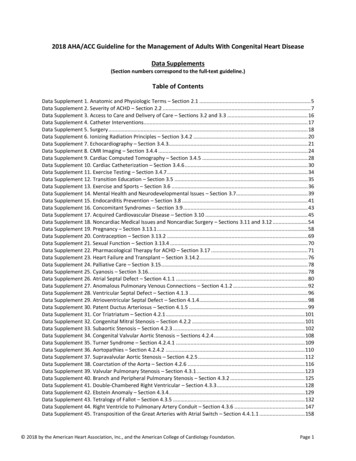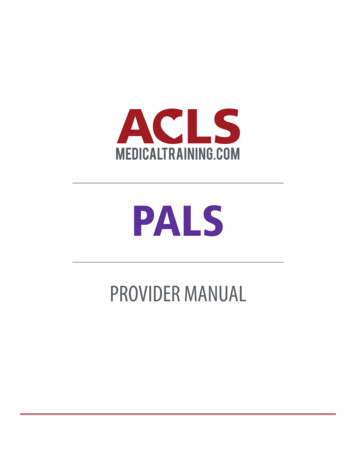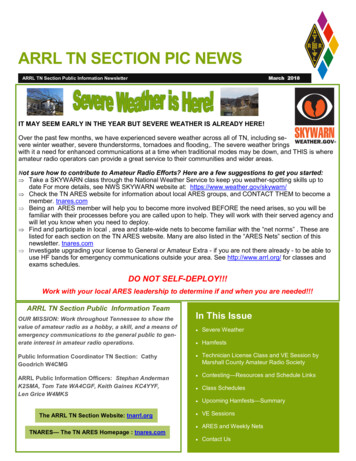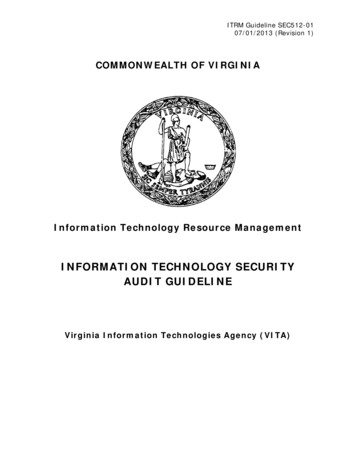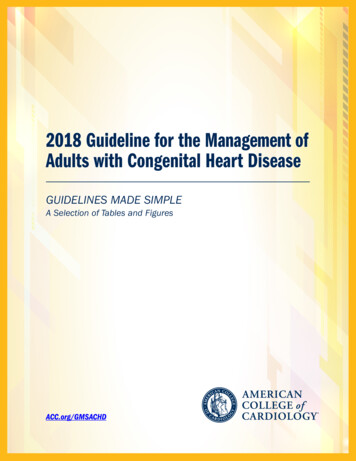
Transcription
2018 Guideline for the Management ofAdults with Congenital Heart DiseaseGUIDELINES MADE SIMPLEA Selection of Tables and FiguresACC.org/GMSACHD
2018 Guideline for the Management of Adults withCongenital Heart DiseaseA report of the American College of Cardiology/American Heart AssociationTask Force on Clinical Practice GuidelinesWriting Committee:Karen K. Stout, MD, FACC, ChairCurt J. Daniels, MD, FACC, Vice ChairJamil A. Aboulhosn, MD, FACC, FSCAIBiykem Bozkurt, MD, PhD, FACC, FAHACraig S. Broberg, MD, FACCJack M. Colman, MD, FACCStephen R. Crumb, DNP, AACJoseph A. Dearani, MD, FACCStephanie Fuller, MD, MS, FACCMichelle Gurvitz, MD, FACCPaul Khairy, MD, PhDMichael J. Landzberg, MD, FACCArwa Saidi, MB, BCH, FACCAnne Marie Valente, MD, FACC, FAHA, FASEGeorge F. Van Hare, MDThe 2018 ACHD guideline is a full revision of the “2008 ACC/AHA Guidelines for the Managementof Adults with Congenital Heart Disease”, which was the first U.S. guideline to be published on thetopic. This revision uses the 2008 ACHD guideline as a framework and incorporates new data andgrowing ACHD expertise to develop recommendations.The following resource contains tables and figures from the 2018 Guideline for theManagement of Adults with Congenital Heart Disease. The resource is only an excerpt fromthe Guideline and the full publication should be reviewed for more tables and figures as wellas important context.CITATION: J Am Coll Cardiol. Aug 2018, 25255; DOI 10.1016/j.jacc.2018.08.1029
2018 Guideline for the Management of Adults withCongenital Heart DiseaseGUIDELINES MADE SIMPLESelected Table or FigurePagePhysiological Variables as Used in ACHD AP Classification 4-7ACHD Anatomic and Physiological (AP) Classification(CHD Anatomy Physiological Stage ACHD AP Classification 8-10Circumstances Where CMR, CCT, TEE, and/or Cardiac Catheterization May be Superior to TTE 11Comparison of Imaging Modalities Useful in ACHD Evaluation 11Specific Management Practices for Cyanotic CH 12Secundum ASD 13Hemodynamically Significant Ventricular Level Shunt 14Isolated PR after Repair of PS 15Pulmonary Valve Replacement in Patients With TOF Repair and PR 16Anomalous Aortic Origin of the Coronary Artery 17Routine Follow-Up and Testing Intervals for Specific Conditions:ASD VSD AVSD PDA Congenital Mitral Stenosis SubAS Supravalvular Aortic Stenosis CoA Valvular PS Branch and Peripheral PS Double-Chambered Right Ventricle Ebstein Anomaly TOF Right Ventricle-to-PA Conduit d-TGA with Atrial Switch d-TGA with Arterial Switch CCTGA Fontan Palliation 181818181919202020212121222223232424Pulmonary Hypertension and Eisenmenger Syndrome 25Routine Follow-Up and Testing Intervals for Congenital Aortic Stenosis 26
ACHDBack to Table of ContentsGUIDELINES MADE SIMPLE2018 Guideline for the Management of Adults with Congenital Heart DiseasePhysiological Variables as Used in ACHD AP Classification (1 of 4)VariableDescriptionAortopathyAortic enlargement is common in some types of CHD and after some repairs. Aorticenlargement may be progressive over a lifetime. There is no universally accepted threshold orrepair, nor is the role of indexing to body size clearly defined in adults, as is done in pediatricpopulations. For purposes of categorization and timing of follow-up imaging: Mild aortic enlargement is defined as maximum diameter 3.5–3.9 cm Moderate aortic enlargement is defined as maximum diameter 4.0–4.9 cm Severe aortic enlargement is defined as maximum diameter 5.0 cmArrhythmiaArrhythmias are very common in patients with ACHD and may be both the cause andconsequence of deteriorating hemodynamics, valvular dysfunction, or ventricular dysfunction.Arrhythmias are associated with symptoms, outcomes, and prognosis, thus are categorizedbased on presence and response to treatment. No arrhythmia–no documented clinically relevant atrial or ventricular tachyarrhythmias Arrhythmia not requiring treatment–bradyarrhythmia, atrial or ventriculartachyarrhythmia not requiring antiarrhythmic therapy, cardioversion, or ablation Arrhythmia controlled with therapy: Bradyarrhythmia requiring pacemaker implantation Atrial or ventricular tachyarrhythmia requiring antiarrhythmic therapy,cardioversion, or ablation AF and controlled ventricular response Patients with an ICD Refractory arrhythmias: Atrial or ventricular tachyarrhythmia not currently responsive to or refractory toantiarrhythmic therapy or ablationConcomitant Severity defined according to the 2014 VHD guidelineVHD Mild VHD Moderate VHD Severe VHDTable 3Table 3 is continued in the next page. For abbreviations please refer to page 7.4
ACHDBack to Table of ContentsGUIDELINES MADE SIMPLE2018 Guideline for the Management of Adults with Congenital Heart DiseasePhysiological Variables as Used in ACHD AP Classification (2 of 4)VariableDescriptionEnd-organdysfunctionClinical and/or laboratory evidence of end-organ dysfunction including Renal (kidney) Hepatic (liver) Pulmonary (lungExercisecapacityPatients with ACHD are often asymptomatic notwithstanding exercise limitationsdemonstrated as diminished exercise capacity when evaluated objectively. Thus, assessmentof both subjective and objective exercise capacity is important (see NYHA classificationsystem below). Exercise capacity is associated with prognosis. Abnormal objective cardiac limitation to exercise is defined as an exercise maximumventilatory equivalent of oxygen below the range expected for the specific CHDanatomic diagnosis. Expected norms for CPET values should take into account age, sex, and underlyingcongenital diagnosis. Published studies with institution-specific norms can be usedas guides, bearing in mind variability among institutional norms and ranges.Hypoxemia/hypoxia/cyanosisSee Section 3.16 for detailed definition of cyanosis. Hypoxemia is defined as oxygen saturation measured by pulse oximetry at rest 90%. Severe hypoxemia is defined as oxygen saturation at rest 85%. In patients with normal or high hemoglobin concentrations, severe hypoxemia will beassociated with visible cyanosis (which requires 5g/L desaturated hemoglobin to beappreciated). The terms cyanosis and hypoxemia (or hypoxia) are sometimes used interchangeably.Such interchangeability would not apply; however, in the presence of anemia, whensevere hypoxemia can be present without visible cyanosis.Table 3Table 3 is continued in the next page. For abbreviations please refer to page 7.5
ACHDBack to Table of ContentsGUIDELINES MADE SIMPLE2018 Guideline for the Management of Adults with Congenital Heart DiseasePhysiological Variables as Used in ACHD AP Classification (3 of ationsystemFunctional CapacityPatients with cardiac disease but resulting in no limitation of physical activity.Ordinary physical activity does not cause undue fatigue, palpitation, dyspnea, oranginal pain.IIPatients with cardiac disease resulting in slight limitation of physical activity. Theyare comfortable at rest. Ordinary physical activity results in fatigue, palpitation,dyspnea, or anginal pain.IIIPatients with cardiac disease resulting in marked limitation of physical activity.They are comfortable at rest. Less than ordinary activity causes fatigue, palpitation,dyspnea, or anginal pain.IVPatients with cardiac disease resulting in inability to carry on any physical activitywithout discomfort. Symptoms of HF or the anginal syndrome may be present evenat rest. If any physical activity is undertaken, discomfort increases.PulmonaryPulmonary hypertension is a broad term that encompasses pulmonary arterial hypertension,hypertension which is pulmonary hypertension with increased pulmonary vascular resistance. Thisdocument defines PH and PAH as they are used in the field of pulmonary hypertension.Pulmonary hypertension is defined: Mean PA pressure by right heart catheterization 25 mm Hg.PAH is defined: Mean PA pressure by right heart catheterization 25 mm Hg and a pulmonarycapillary wedge pressure 15 mm Hg and pulmonary vascular resistance 3 Wood unitsTable 3Table 3 is continued in the next page. For abbreviations please refer to page 7.6
ACHDBack to Table of ContentsGUIDELINES MADE SIMPLE2018 Guideline for the Management of Adults with Congenital Heart DiseasePhysiological Variables as Used in ACHD AP Classification (4 of antshunt)An intracardiac shunt is hemodynamically significant if: There is evidence of chamber enlargement distal to the shuntVenous andarterialstenosis And/or evidence of sustained Qp:Qs 1.5:1 An intracardiac shunt not meeting these criteria would be described as small or trivial Aortic recoarctation after CoA repair Supravalvular aortic obstruction Venous baffle obstruction Supravalvular pulmonary stenosis Branch PA stenosis Stenosis of cavopulmonary connection Pulmonary vein stenosisTable 3ACHD indicates adult congenital heart disease; AF, atrial fibrillation; AP, anatomic and physiologic; CHD, congenitalheart disease; CoA, coarctation of the aorta; CPET, cardiopulmonary exercise test; HF, heart failure; ICD, implantablecardioverter-defibrillator; NYHA, New York Heart Association; PA, pulmonary artery; PAH, pulmonary arterial hypertension;Qp:Qs, pulmonary–systemic blood flow ratio; and VHD, valvular heart disease.7
ACHDBack to Table of ContentsGUIDELINES MADE SIMPLE2018 Guideline for the Management of Adults with Congenital Heart DiseaseACHD Anatomic and Physiological (AP) Classification(CHD Anatomy Physiological Stage ACHD AP Classification)(1 of 3)CHD Anatomy*I: SimpleNative disease Isolated small ASD Isolated small VSD Mild isolated pulmonic stenosisRepaired conditions Previously ligated or occluded ductus arteriosus Repaired secundum ASD or sinus venosus defect without significant residual shunt or chamber enlargement Repaired VSD without significant residual shunt or chamber enlargementII: Moderate ComplexityRepaired or unrepaired conditions Aorto-left ventricular fistula Anomalous pulmonary venous connection, partial or total Anomalous coronary artery arising from the pulmonary artery Anomalous aortic origin of a coronary artery from the opposite sinus AVSD (partial or complete, including primum ASD) Congenital aortic valve disease Congenital mitral valve disease Coarctation of the aorta Ebstein anomaly (disease spectrum includes mild, moderate, and severe variations) Infundibular right ventricular outflow obstruction Ostium primum ASD Moderate and large unrepaired secundum ASD Moderate and large persistently patent ductus arteriosus Pulmonary valve regurgitation (moderate or greater) Pulmonary valve stenosis (moderate or greater) Peripheral pulmonary stenosis Sinus of Valsalva fistula/aneurysm Sinus venosus defect Subvalvar aortic stenosis (excluding HCM; HCM not addressed in these guidelines) Supravalvar aortic stenosis Straddling AV valve Repaired tetralogy of Fallot VSD with associated abnormality and/or moderate or greater shuntCHD Anatomy will continue in the next page. For abbreviations please refer to page 10.*This list is not meant to be comprehensive; other conditions may be important in individual patients.Table 48
ACHDBack to Table of ContentsGUIDELINES MADE SIMPLE2018 Guideline for the Management of Adults with Congenital Heart DiseaseACHD Anatomic and Physiological (AP) Classification(CHD Anatomy Physiological Stage ACHD AP Classification)(2 of 3)CHD Anatomy*III: Great Complexity (or Complex) Cyanotic congenital heart defect (unrepaired or palliated, all forms) Double-outlet ventricle Fontan procedure Interrupted aortic arch Mitral atresia Single ventricle (including double inlet left ventricle, tricuspid atresia, hypoplastic left heart, any otheranatomic abnormality with a functionally single ventricle) Pulmonary atresia (all forms) TGA (classic or d-TGA; CCTGA or l-TGA) Truncus arteriosus Other abnormalities of AV and ventriculoarterial connection (i.e., crisscross heart, isomerism, heterotaxysyndromes, ventricular inversion)Physiological StageA NYHA FC I symptoms No hemodynamic or anatomic sequelae No arrhythmias Normal exercise capacity Normal renal/hepatic/pulmonary functionB NYHA FC II symptoms Mild hemodynamic sequelae (mild aortic enlargement, mild ventricular enlargement, mild ventriculardysfunction) Mild valvular disease Trivial or small shunt (not hemodynamically significant) Arrhythmia not requiring treatment Abnormal objective cardiac limitation to exercisePhysiological Stage will continue in the next page. For abbreviations please refer to page 10.*This list is not meant to be comprehensive; other conditions may be important in individual patients.Table 49
ACHDBack to Table of ContentsGUIDELINES MADE SIMPLE2018 Guideline for the Management of Adults with Congenital Heart DiseaseACHD Anatomic and Physiological (AP) Classification(CHD Anatomy Physiological Stage ACHD AP Classification)(3 of 3)Physiological StageC NYHA FC III symptoms Significant (moderate or greater) valvular disease; moderate or greater ventricular dysfunction (systemic,pulmonic, or both) Moderate aortic enlargement Venous or arterial stenosis Mild or moderate hypoxemia/cyanosis Hemodynamically significant shunt Arrhythmias controlled with treatment Pulmonary hypertension (less than severe) End-organ dysfunction responsive to therapyD NYHA FC IV symptoms Severe aortic enlargement Arrhythmias refractory to treatment Severe hypoxemia (almost always associated with cyanosis) Severe pulmonary hypertension Eisenmenger syndrome Refractory end-organ dysfunctionTable 4ACHD indicates adult congenital heart disease; AP, anatomic and physiologic; ASD, atrial septal defect; AV, atrioventricular;AVSD, atrioventricular septal defect; CCTGA, congenitally corrected transposition of the great arteries; CHD, congenitalheart disease; d-TGA, dextro-transposition of the great arteries; FC, functional class; HCM, hypertrophic cardiomyopathy;l-TGA, levo-transposition of the great arteries; NYHA, New York Heart Association; TGA, transposition of the great arteries;and VSD, ventricular septal defect.10
ACHDBack to Table of ContentsGUIDELINES MADE SIMPLE2018 Guideline for the Management of Adults with Congenital Heart DiseaseCircumstances Where CMR, CCT, TEE, and/orCardiac Catheterization May be Superior to TTE Assessment of RV size and function in repaired TOF, systemic right ventricles, and other conditionsassociated with RV volume and pressure overload Identification of anomalous pulmonary venous connections Serial assessment of thoracic aortic aneurysms, especially when the dilation might extend beyond theechocardiographic windows Accurate assessment of PA pressure and pulmonary vascular resistance Assessment for recoarctation of the aorta Sinus venosus defects Vascular rings Evaluation of coronary anomalies Quantification of valvular regurgitationTable 11Comparison of Imaging Modalities Useful in ACHD EvaluationRadiation vularStructure/FunctionCoronaryAnatomyand o /- /-CMRNo * CCTYes * CardiacCatheterizationYes *In specific gated imaging protocols.Table 9 indicates less expensive; , more expensive; /-, possible value; , good; , very good; and , excellent.ACHD indicates adult congenital heart disease; CCT, cardiac computed tomography; and CMR, cardiovascular magneticresonance.11
ACHDBack to Table of ContentsGUIDELINES MADE SIMPLE2018 Guideline for the Management of Adults with Congenital Heart DiseaseSpecific Management Practices for Cyanotic CHD Recording clinical oxygen saturation at rest ( 5 min) rather than immediately after effort (e.g., walkinginto a clinic examination room); Meticulous intravenous care to avoid air or particulate matter, which may include use of air/particulatefilters on all intravenous access lines, when feasible, and careful de-airing of all lines; Cerebral imaging for any new headache or neurologic sign to assess for possible cerebral abscess,hemorrhage, or stroke; Measurement of serum uric acid and treatment with allopurinol in a patient with a history of gout; Supplemental oxygen as needed for symptom relief but not to a target oxygen saturation level and not ifthere is no demonstrable symptomatic benefit; Avoidance of or cautious use of therapies that may reduce the patient's hypoxia-mediated drive toventilation, such as narcotics or, in rare circumstances, excess supplemental oxygen; Anesthesia by providers with expertise in anesthesia for patients with ACHD for any noncardiac surgery; Non-estrogen–containing birth control for women of child-bearing potential (intrauterine device may be apreferred option). Avoidance of birth control entirely is not a safe acceptable option. Patients can fly safely on commercial airlines without undue risk. Preflight simulation testing ormandated supplemental oxygen are not usually indicated, though adequate hydration and movementduring the flight are appropriate; Measurement of coagulation parameters (e.g., activated partial thromboplastin time, internationalnormalized ratio, thrombin time) in a patient with an elevated hematocrit 55% requires adjustment ofanticoagulant volume in the blood collection vials to account for reduced plasma volume in the draw.Table 1212
ACHDBack to Table of ContentsGUIDELINES MADE SIMPLE2018 Guideline for the Management of Adults with Congenital Heart DiseaseSecundum ASDSecundum ASDShuntdirectionRight-to-left(e.g., mentPulmonary vascular resistance 1/3systemic vascular resistance, PASP 50% systemic, right heartenlargement, AND shunt largeenough to cause physiologicsequelae (e.g., Qp:Qs 1.5:1)FunctionalimpairmentYesSurgical ordevice closure(Class I)NoPulmonary vascularresistance 1/3 systemic,AND/OR PASP 50%systemicConfirm PAH diagnosis(often requiring invasivehemodynamicassessment)(Class I)Bosentan(Class I)PDE-5 inhibitors(Class IIa)YesCombinationtherapy*(Class IIa)No closure(Class III: Harm)Consultation withACHD and PH experts(Class I)Surgical ordevice closure(Class IIb)Surgical ordevice closure(Class IIa)Figure 1*Combination therapy with bosentan and PDE-5 inhibitor if symptomatic improvement does not occur with either alone.ACHD indicates adult congenital heart disease; ASD, atrial septal defect; PAH, pulmonary artery hypertension; PASP, pulmonary artery systolicpressure; PDE-5, phosphodiesterase type-5 inhibitors; PH, pulmonary hypertension; and Qp:Qs, pulmonary–systemic blood flow ratio.13
ACHDBack to Table of ContentsGUIDELINES MADE SIMPLE2018 Guideline for the Management of Adults with Congenital Heart DiseaseHemodynamically Significant Ventricular Level ShuntHemodynamically significant ventricular level shuntShuntdirectionRight-to-left(e.g., mentLV enlargement Qp:Qs 1.5:1,PASP 50% systemic,AND pulmonary vascularresistance 1/3 systemicYesSurgical ordevice closure(Class I)Pulmonary vascularresistance 1/3 systemic,AND/OR PASP 50%systemicNoSurgical ordevice closure(Class IIa)PDE-5 inhibitors(Class IIa)YesCombinationtherapy*(Class IIa)No closure(Class III: Harm)Consultation withACHD and PH experts(Class I)Progressive AR dueto perimembranousor supracristal VSDYesConfirm PAH diagnosis(often requiring invasivehemodynamicassessment)(Class I)Bosentan(Class I)Surgical ordevice closure(Class IIb)NoHistoryof IEYesSurgical ordevice closure(Class IIb)NoContinuedfollow-upFigure 2*Combination therapy with bosentan and PDE-5 inhibitor, if symptomatic improvement does not occur with either alone.ACHD indicates adult congenital heart disease; AR, aortic regurgitation; IE, infective endocarditis; LV, left ventricular; PAH, pulmonary arteryhypertension; PASP, pulmonary artery systolic pressure; PDE-5, phosphodiesterase type-5 inhibitors; PH, pulmonary hypertension; Qp:Qs,pulmonary–systemic blood flow ratio; and VSD, ventricular septal defect.14
ACHDBack to Table of ContentsGUIDELINES MADE SIMPLE2018 Guideline for the Management of Adults with Congenital Heart DiseaseIsolated PR after Repair of PSIsolated PR after repair of PSAssessment ofPR severity andRV size/functionMild PR and RVenlargement*Moderate orgreater PR andRV enlargement*Interval follow-up(Class I)Symptoms†YesNoPulmonary valvereplacement(Class I)Imagingand CPET(Class I)ProgressiveRV dilation and/or RV dysfunctionand/or progressive decreasein exercise capacityYesPulmonary valvereplacement(Class IIb)NoInterval follow-up withACHD cardiologist(Class I)Figure 3*Significant PR causes RV dilation. If a patient has moderate or greater PR and normal RV size, most likely the estimation of PR severity isinaccurate or there may be restrictive RV physiology, which would warrant further investigation.†Symptoms may include dyspnea, chest pain, and/or exercise intolerance referable to PR or otherwise unexplained.ACHD indicates adult congenital heart disease; CPET, cardiopulmonary exercise test; PR, pulmonary regurgitation; PS, pulmonary stenosis;and RV, right ventricular.15
ACHDBack to Table of ContentsGUIDELINES MADE SIMPLE2018 Guideline for the Management of Adults with Congenital Heart DiseasePulmonary Valve Replacement in Patients With TOF Repair and PRTOF repair with PRSeverelydecreasedYes LV or RV systolicfunctionEvaluation by an ACHDcardiologist & advancedHF team(Class I)NoPR severityMild PRModerateor more PRFollow-up withACHD cardiologist(Class I)Symptoms*YesNoPulmonary valvereplacement(Class I)Any 2 of the following: Mild or moderate RV or LVsystolic dysfunction Severe RV dilation (RVEDVI 160mL/m2, or RVESVI 80 mL/m2,or RVEDV 2 x LVEDV) RVSP due to RVOT obstruction 2/3 systemic pressure Progressive reduction in objectiveexercise toleranceYesPulmonary valvereplacement(Class IIa)NoSustainedtachyarrhythmiasYesPulmonary valvereplacement(Class IIb)NoResidual lesionsrequiring surgicalinterventionsYes*Symptoms may include dyspnea, chest pain, and/or exerciseintolerance referable to PR or otherwise unexplained.ACHD indicates adult congenital heart disease; HF, heart failure; LV, leftventricular; LVEDV, left ventricular end diastolic volume; PR, pulmonaryregurgitation; RV, right ventricular; RVEDV, right ventricular end diastolicvolume; RVEDVI, right ventricular end16Pulmonary valvereplacement(Class IIb)Figure 4NoFollow-up withACHD cardiologist(Class I)
ACHDBack to Table of ContentsGUIDELINES MADE SIMPLE2018 Guideline for the Management of Adults with Congenital Heart DiseaseAnomalous Aortic Origin of the Coronary ArteryAnomalous aortic originof the coronary arteryLeft coronary fromthe right sinusRight coronary fromthe left sinusIschemic symptomsor ischemia duringdiagnostic testingIschemic symptomsor ischemia duringdiagnostic testingYesSurgicalintervention*(Class I)NoSurgicalintervention*(Class IIa)YesSurgicalintervention*(Class I)NoSurgicalintervention*(Class n(Class IIb)Surgicalintervention*(Class IIa)Figure 5*Surgical intervention to involve unroofing or coronary revascularization for patients with concomitant fixed obstruction.17
ACHDBack to Table of ContentsGUIDELINES MADE SIMPLE2018 Guideline for the Management of Adults with Congenital Heart DiseaseRoutine Follow-Up and Testing Intervals for Specific ConditionsPhysiologicStage A*(months)PhysiologicStage B*(months)PhysiologicStage C*(months)PhysiologicStage D*(months)Outpatient ACHD E36–60241212Pulse OximetryAs neededAs neededEach visitEach visitExercise Test†As neededAs needed12–246–12Outpatient ACHD ulse OximetryAs neededAs neededEach visitEach visitExercise Test†As neededAs needed12–246–12Outpatient ACHD E24–36241212Pulse OximetryAs neededAs neededEach visitEach visitExercise Test†As neededAs needed12–246–12Outpatient ACHD E36–60241212Pulse Oximetry†As neededAs neededEach visitEach visitExercise Test ‡As neededAs needed12–246–12Frequency of RoutineFollow-Up and TestingASDVSDAVSDPDA*See Tables 3 and 4 for details on the ACHD AP classification system.ASD (Table 13), VSD (Table 14), and AVSD (Table 15):†6-minute walk test or cardiopulmonary exercise test, depending on the clinical indication.PDA (Table 16):†Upper and lower extremity.‡6-minutewalk test or cardiopulmonary exercise test, depending on the clinical indication.Abbreviations are listed on page 25.18
ACHDBack to Table of ContentsGUIDELINES MADE SIMPLE2018 Guideline for the Management of Adults with Congenital Heart DiseaseRoutine Follow-Up and Testing Intervals for Specific ConditionsFrequency of RoutineFollow-Up and TestingPhysiologicStage A*(months)PhysiologicStage B*(months)PhysiologicStage C*(months)PhysiologicStage D*(months)Congenital Mitral StenosisOutpatient ACHD s needed242412Outpatient ACHD s needed242412Exercise Test†SubASExercise Test†*See Tables 3 and 4 for details on the ACHD AP classification system.†6-minutewalk test or cardiopulmonary exercise test, depending on the clinical indication.Congenital Mitral Stenosis (Table 17), SubAS (Table 18)Abbreviations are listed on page 25.19
ACHDBack to Table of ContentsGUIDELINES MADE SIMPLE2018 Guideline for the Management of Adults with Congenital Heart DiseaseRoutine Follow-Up and Testing Intervals for Specific ConditionsFrequency of RoutineFollow-Up and TestingPhysiologicStage A*(months)PhysiologicStage B*(months)PhysiologicStage C*(months)PhysiologicStage D*(months)Supravalvular Aortic StenosisOutpatient ACHD 12CMR ‡/CCT§36–6036–6036–6036–60Exercise Test IIAs needed242412Outpatient ACHD 12CMR ‡/CCT§36–6036–6012–2412–24Exercise Test II36242412Outpatient ACHD E36–60241212As needed242412CoAValvular PSExercise Test†*See Tables 3 and 4 for details on the ACHD AP classification system.†Routine TTEmay not be necessary in a year when CMR imaging is performed unless clinical indications warrant otherwise.II6-minute walk test or cardiopulmonary exercise test, depending on the clinical indication.Supravalvular Aortic Stenosis (Table 20):‡CMR may be indicated for assessment of aortic anatomy. Baseline study is recommended with periodic follow-up CMR,with frequency of repeat imaging determined by anatomic and physiological findings.§If CCT is utilized instead of CMR imaging, the frequency should be weighed against radiation exposure.CoA (Table 21):‡CMR may be indicated for assessment of aortic size and aortic arch/coarctation repair site anatomy. Baseline study isrecommended with periodic follow-up CMR, with frequency of repeat imaging determined by anatomic and physiologicalfindings.§CCT may be utilized if CMR is not feasible and to evaluate cross-sectional imaging status-post stent therapy for coarctationof the aorta; the frequency should be weighed against radiation exposure.Valvular PS (Table 23):†6-minute walk test or cardiopulmonary exercise test, depending on clinical indication.Abbreviations are listed on page 25.20
ACHDBack to Table of ContentsGUIDELINES MADE SIMPLE2018 Guideline for the Management of Adults with Congenital Heart DiseaseRoutine Follow-Up and Testing Intervals for Specific ConditionsPhysiologicStage A*(months)PhysiologicStage B*(months)PhysiologicStage C*(months)PhysiologicStage D*(months)Outpatient ACHD E†24–36241212CMR ‡/CCT§36–6036–6024–3624–36Exercise Test II36242412Frequency of RoutineFollow-Up and TestingBranch and Peripheral PSDouble-Chambered Right VentricleOutpatient ACHD E24–36241212As needed242412Outpatient ACHD RAs neededAs needed12–2412–24TTE†12–2412–241212Pulse Oximetry2412Each visitEach visitHolter MonitorAs neededAs needed2412–24CMR ‡/CCT§603624–3612–24Exercise Test II3624–362412Exercise Test†Ebstein Anomaly*See Tables 3 and 4 for details on the ACHD AP classification system.Branch and Peripheral PS (Table 24) and Ebstein Anomaly (Table 26):†Routine TTE may not be necessary in a year when CMR imaging is performed unless clinical indications warrant otherwise.II6-minute walk test or cardiopulmonary exercise test, depending on the clinical indication.Branch and Peripheral PS (Table 24):‡CMR may be indicated for assessment of branch PS. Baseline study is recommended with periodic follow-up CMR, withfrequency of repeat imaging determined by anatomic and physiological findings.§CCT may be utilized if CMR is not feasible and to evaluate cross-sectional imaging status-post stent therapy for peripheralPS; the frequency should be weighed against radiation exposure.Double-Chambered Right Ventricle (Table 25):†6-minute walk test or cardiopulmonary exercise test, depending on clin
2018 Guideline for the Management of Adults with Congenital Heart Disease ACHD 5 Bac to Table of Contents Clinical and/or laboratory evidence of end-organ dysfunction including Renal (kidney) Hepatic (liver) Pulmonary (lung Patients with ACHD are often asymptomatic notwithstanding exercise limitations





